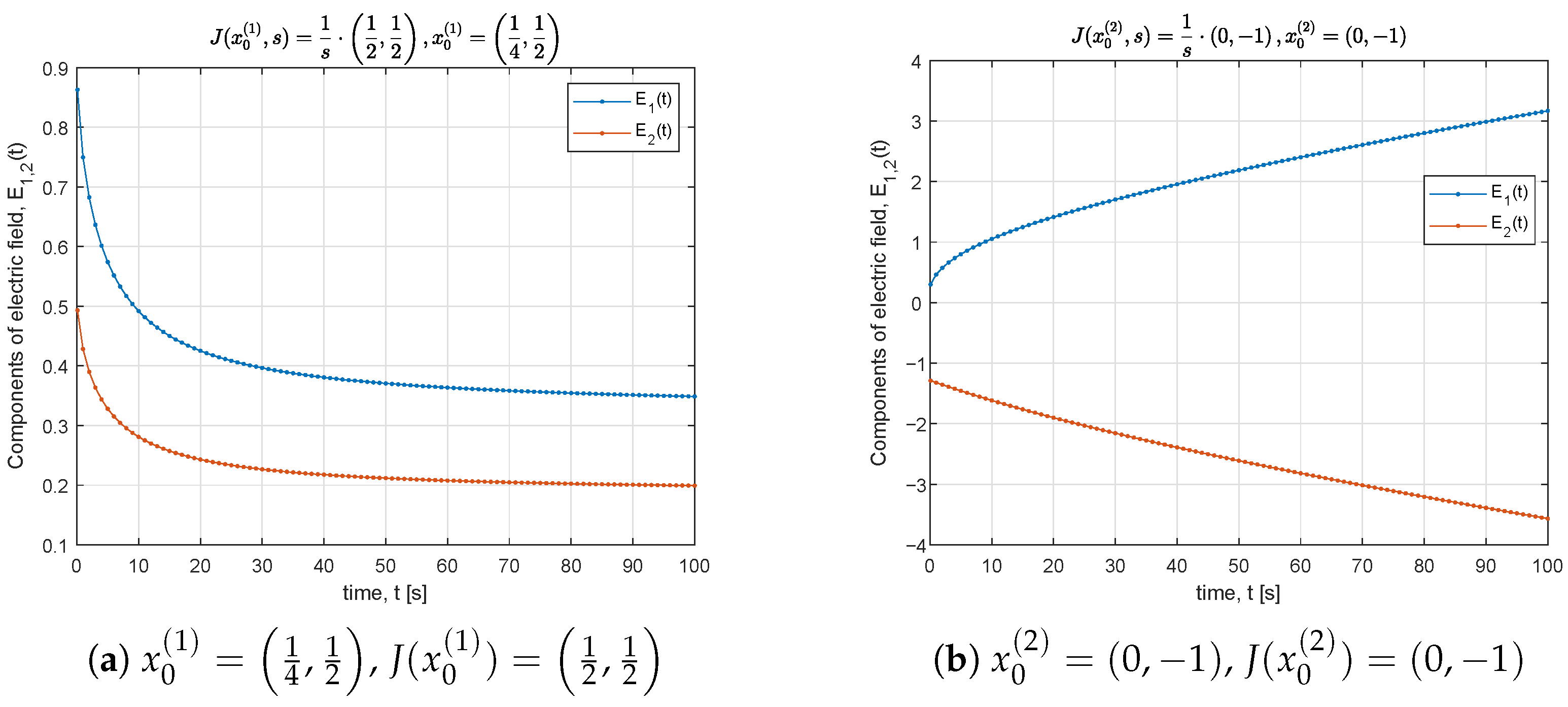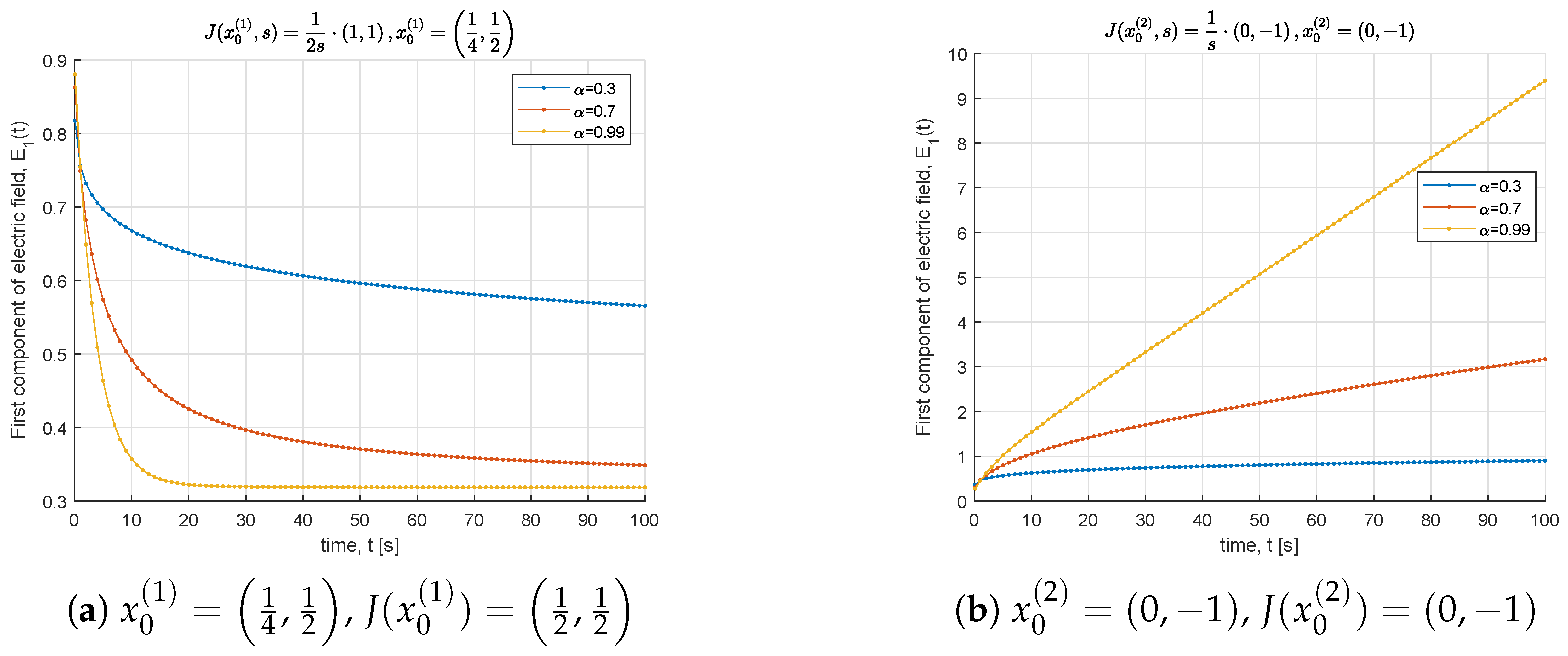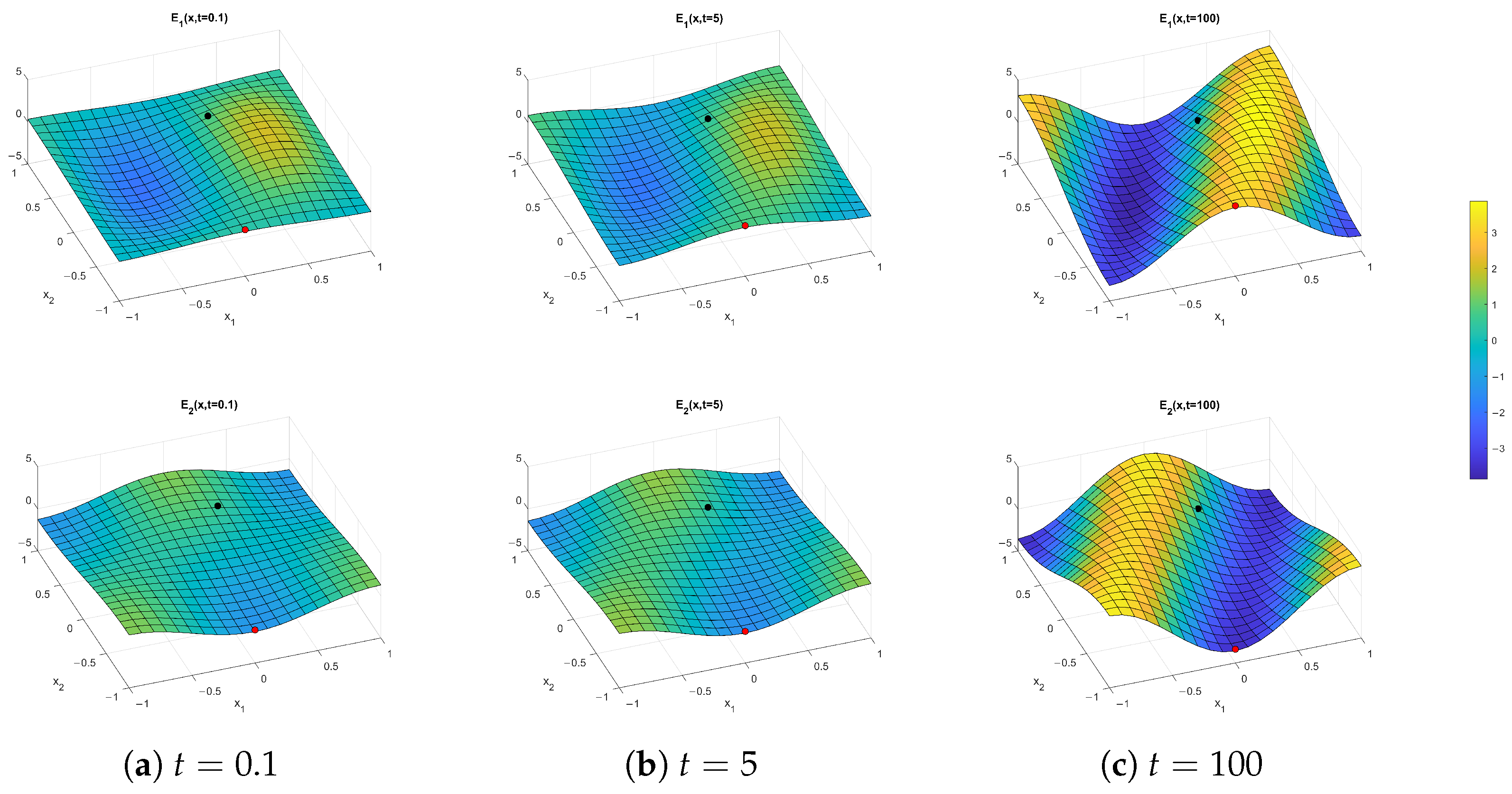Dissipativity Constraints in Zener-Type Time Dispersive Electromagnetic Materials of the Fractional Type
Abstract
1. Introduction
2. Preliminary
2.1. Notation and Framework
2.2. Constitutive Relations and Dissipativity of the Dispersive Electromagnetic Materials
3. Thermodynamic Restrictions
3.1. General Results
3.2. Restrictions for the Fractional Zener-Type Model of Dispersive Anisotropic Electromagnetic Materials
3.3. Anisotropic Model with the Assumption
- (3D)
- A non-homogeneous model in with a dimensional matrix Q;
- (3D-H)
- A non-homogeneous model in with a dimensional matrix Q, which is homogeneous with respect to the third variable .
3.4. Anisotropic Material with Assumption in the 3D-H Case
4. The Analysis of in the 2D Case
5. Numerical Results
6. Conclusions
Author Contributions
Funding
Data Availability Statement
Acknowledgments
Conflicts of Interest
References
- Orfanidis, S.J. Electromagnetic Waves and Antennas. 2016. Available online: https://www.mathworks.com/academia/books/electromagnetic-waves-and-antennas-orfanidis.html (accessed on 7 November 2024).
- Nunes, F.D.; Vasconcelos, T.C.; Bezerra, M.; Weiner, J. Electromagnetic energy density in dispersive and dissipative media. J. Opt. Soc. Am. B 2011, 28, 1544–1552. [Google Scholar] [CrossRef]
- Caloz, C.; Itoh, T. Electromagnetic Metamaterials: Transmission Line Theory and Microwave Applications; John Wiley & Sons: Hoboken, NJ, USA, 2005. [Google Scholar] [CrossRef]
- Jackson, J.D. Classical Electrodynamics, 2nd ed.; John Wiley & Sons: Hoboken, NJ, USA, 1975; Chapter 7. [Google Scholar]
- Quan, L.; Alù, A. Passive Acoustic Metasurface with Unitary Reflection Based on Nonlocality. Phys. Rev. Appl. 2019, 11, 054077. [Google Scholar] [CrossRef]
- Kwon, H.; Sounas, D.; Cordaro, A.; Polman, A.; Alù, A. Nonlocal Metasurfaces for Optical Signal Processing. Phys. Rev. Lett. 2018, 121, 173004. [Google Scholar] [CrossRef] [PubMed]
- Nasrolahpour, H. A note on fractional electrodynamics. Commun. Nonlinear Sci. Numer. Simul. 2013, 18, 2589–2593. [Google Scholar] [CrossRef]
- Nasrolahpour, H. Fractional electromagnetic metamaterials. Optik 2020, 203, 163969. [Google Scholar] [CrossRef]
- Karlsson, A.; Kristensson, G. Constitutive Relations, Dissipation, and Reciprocity for the Maxwell Equations in the Time Domain. J. Electromagn. Waves Appl. 1992, 6, 537–551. [Google Scholar] [CrossRef]
- Coleman, B.; Dill, E. Thermodynamic restrictions on the constitutive equations of electromagnetic theory. Z. Angew. Math. Phys. 1971, 22, 691–702. [Google Scholar] [CrossRef]
- Coleman, B.D.; Dill, E.H. On the thermodynamics of electromagnetic fields in materials with memory. Arch. Ration. Mech. Anal. 1971, 41, 132–162. [Google Scholar] [CrossRef]
- Cassier, M.; Joly, P.; Kachanovska, M. Mathematical models for dispersive electromagnetic waves: An overview. Comput. Math. Appl. 2017, 74, 2792–2830. [Google Scholar] [CrossRef]
- Amendola, G.; Fabrizio, M.; Golden, J.M. A Mathematical Model for Visco-Ferromagnetic Materials. Prog. Fract. Differ. Appl. 2020, 6, 245–252. [Google Scholar] [CrossRef]
- Cassier, M.; Hazard, C.; Joly, P. Spectral theory for Maxwell’s equations at the interface of a metamaterial. Part I: Generalized Fourier transform. Commun. Partial. Differ. Equ. 2017, 42, 1707–1748. [Google Scholar] [CrossRef]
- Kovačević, J.; Cvetićanin, S.M.; Zorica, D. Electromagnetic field in a conducting medium modeled by the fractional Ohm’s law. Commun. Nonlinear Sci. Numer. Simul. 2022, 114, 106706. [Google Scholar] [CrossRef]
- Moreles, M.A.; Lainez, R. Mathematical modelling of fractional order circuit elements and bioimpedance applications. Commun. Nonlinear Sci. Numer. Simul. 2017, 46, 81–88. [Google Scholar] [CrossRef]
- Truesdell, C. Das ungelöste Hauptproblem der endlichen Elastizitätstheorie. ZAMM Z. Angew. Math. Mech. (J. Appl. Math. Mech.) 1956, 36, 97–103. [Google Scholar] [CrossRef]
- Fabrizio, M.; Morro, A. Dissipativity and irreversibility of electromagnetic systems. Math. Model. Methods Appl. Sci. 2000, 10, 217–246. [Google Scholar] [CrossRef]
- Fabrizio, M.; Morro, A. Mathematical Problems in Linear Viscoelasticity; Society for Industrial and Applied Mathematics: Philadelphia PA, USA, 1992. [Google Scholar]
- Šarčev, I.; Šarčev, B.P.; Krstonošić, V.; Janev, M.; Atanacković, T.M. Modeling the rheological properties of four commercially available composite core build-up materials. Polym. Polym. Compos. 2021, 29, 931–938. [Google Scholar] [CrossRef]
- Atanacković, T.M.; Janev, M.; Pilipović, S. On the thermodynamical restrictions in isothermal deformations of fractional Burgers model. Philos. Trans. R. Soc. Math. Phys. Eng. Sci. 2020, 378, 20190278. [Google Scholar] [CrossRef] [PubMed]
- Atanacković, T.M.; Pilipović, S.; Stanković, B.; Zorica, D. Fractional Calculus with Applications in Mechanics: Vibrations and Diffusion Processes; John Wiley & Sons, Inc.: Hoboken, NJ, USA, 2014. [Google Scholar] [CrossRef]
- Bagley, R.; Torvik, P. On the Fractional Calculus Model of Viscoelastic Behavior. J. Rheol. 1986, 30, 133–155. [Google Scholar] [CrossRef]
- Schwartz, L. Théorie des Distributions; Hermann: Paris, France, 1966; pp. xiii+420. [Google Scholar]
- Vladimirov, V.S. Methods of the theory of generalized functions. In Analytical Methods and Special Functions; Taylor & Francis: London, UK, 2002; Volume 6, pp. xiv+311. [Google Scholar]
- Reed, M.; Simon, B. Methods of Modern Mathematical Physics: Functional Analysis; Number 1 in Methods of Modern Mathematical Physics; Academic Press: Cambridge, MA, USA, 1980. [Google Scholar]
- Micheli, M.; Glaunes, J. Matrix-valued Kernels for Shape Deformation Analysis. Geom. Imaging Comput. 2013, 1, 57–139. [Google Scholar] [CrossRef]
- Doetsch, G. Introduction to the Theory and Application of the Laplace Transformation; Springer: Berlin/Heidelberg, Germany, 1974. [Google Scholar] [CrossRef]
- McClure, T. Numerical Inverse Laplace Transform. MATLAB Central File Exchange. 2013. Available online: https://www.mathworks.com/matlabcentral/fileexchange/39035-numerical-inverse-laplace-transform (accessed on 7 November 2024).



Disclaimer/Publisher’s Note: The statements, opinions and data contained in all publications are solely those of the individual author(s) and contributor(s) and not of MDPI and/or the editor(s). MDPI and/or the editor(s) disclaim responsibility for any injury to people or property resulting from any ideas, methods, instructions or products referred to in the content. |
© 2025 by the authors. Licensee MDPI, Basel, Switzerland. This article is an open access article distributed under the terms and conditions of the Creative Commons Attribution (CC BY) license (https://creativecommons.org/licenses/by/4.0/).
Share and Cite
Atanacković, T.M.; Janev, M.; Narandžić, M.; Pilipović, S. Dissipativity Constraints in Zener-Type Time Dispersive Electromagnetic Materials of the Fractional Type. Fractal Fract. 2025, 9, 342. https://doi.org/10.3390/fractalfract9060342
Atanacković TM, Janev M, Narandžić M, Pilipović S. Dissipativity Constraints in Zener-Type Time Dispersive Electromagnetic Materials of the Fractional Type. Fractal and Fractional. 2025; 9(6):342. https://doi.org/10.3390/fractalfract9060342
Chicago/Turabian StyleAtanacković, Teodor M., Marko Janev, Milan Narandžić, and Stevan Pilipović. 2025. "Dissipativity Constraints in Zener-Type Time Dispersive Electromagnetic Materials of the Fractional Type" Fractal and Fractional 9, no. 6: 342. https://doi.org/10.3390/fractalfract9060342
APA StyleAtanacković, T. M., Janev, M., Narandžić, M., & Pilipović, S. (2025). Dissipativity Constraints in Zener-Type Time Dispersive Electromagnetic Materials of the Fractional Type. Fractal and Fractional, 9(6), 342. https://doi.org/10.3390/fractalfract9060342







